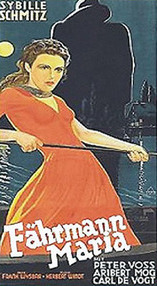| This article needs additional citations for verification. Please help improve this article by adding citations to reliable sources. Unsourced material may be challenged and removed. Find sources: "Fährmann Maria" – news · newspapers · books · scholar · JSTOR (April 2018) (Learn how and when to remove this message) |
| Fährmann Maria | |
|---|---|
 Theatrical poster Theatrical poster | |
| Directed by | Frank Wisbar |
| Written by |
|
| Produced by | Eberhard Schmidt |
| Starring |
|
| Cinematography | Franz Weihmayr |
| Edited by | Lena Neumann |
| Music by | Herbert Windt |
| Distributed by | Pallas Film (II) |
| Release date |
|
| Running time | 83 minutes |
| Country | Germany |
| Language | German |
Fährmann Maria (lit. Ferryman Maria) is a 1936 German horror film directed by Frank Wisbar and starring Sybille Schmitz.
Plot
An elderly man operates a ferry near a small village. One evening, he weakens and dies while ferrying a silent stranger dressed in black.
Some time later, a homeless woman arrives in the village seeking employment, and takes over the ferrying duties. The next evening, a wounded man boards her ferry. She hides him from his pursuers and nurses him back to health in her hut. Gradually, they fall in love.
Soon the silent stranger in black appears on the far shore, summoning the ferry. As they cross the river, he eventually breaks his silence to inquire about the wounded man. Maria realizes that the stranger is Death itself, and she seeks to outwit him by directing him away from her hut and into the village where a festival is in progress. The villagers at the festival recoil from the stranger, who dances with Maria until she escapes from him and runs to a church. She falls to the floor and prays for death to take her and spare the wounded man.
The stranger finds Maria in the church and demands to be led to her hut. To reach it they must walk across a marsh. As they negotiate the treacherous path through the marsh, Maria again prays that her own life be sacrificed so the man she has been sheltering may live. The stranger makes a wrong step and sinks into the mud. The marsh swallows him completely and Maria gets safely away.
The next morning, Maria and her lover ferry to the opposite shore to begin a new life together.
Cast
- Sybille Schmitz as Maria
- Aribert Moog as Wounded man
- Peter Voß as the Stranger / Death
- Karl Platen as The Ferryman
Production
The interior scenes were shot in Berlin studios from August to October in 1935 while the outdoor scenes were filmed in Lower Saxony (the Hamburg, Bremen and Hanover areas) near a farm called Tütsberg in the village of Heber, and also near Soltau.
Release
The film premiered at the Bernward Light Games in Hildesheim on January 7, 1936.
Awards
The National Socialists had changed film inspection standards in 1934 (originally to increase the quality of film production by creating censorship standards) to also cover film awards, and as a result movies would be awarded extra consideration, and lower taxes, if they were deemed state-politically and artistically particularly valuable. Though Joseph Goebbels, Propaganda Minister for the Third Reich, dismissed it as "an experiment, but not a good one", the film still received an award for artistic value.
Remake
After Wisbar emigrated from Germany to the U.S. following the November pogroms of 1938 (Kristallnacht) he worked odd jobs in cinema. In 1945, he remade Fährmann Maria as Strangler of the Swamp for Producers Releasing Corporation. The remake was filmed quickly on a small budget, and was more horrific than the atmospheric original.
References
Notes
- Hans-Jürgen Tast "Fährmann Maria". 80 years ago world premiere at the Hildesheimer Kino; In: Sven Abromeit (Red.) Hildesheimer Calendar 2016. Yearbook for History and Culture, Hildesheim 2015, ISSN 1863-5393, ISBN 978-3-8067-8616-3, pp. 133–143
- Hans-Jürgen Tast „Fährmann Maria“. Vor 80 Jahren Welturaufführung im Hildesheimer Kino; in: Sven Abromeit (Red.) Hildesheimer Kalender 2016. Jahrbuch für Geschichte und Kultur, Hildesheim 2015, ISSN 1863-5393, ISBN 978-3-8067-8616-3, S. 133–143
- Nicolella, Henry. Frank Wisbar: The Director of Ferryman Maria, from Germany to America and Back. McFarland, Incorporated, 2018. pp. 113, 116. ISBN 9781476629766
Bibliography
- William K. Everson: Classics of the horror film (Citadel film books). Munich, 1979
- Christa Bandmann / Joe Hembus: Classics of German sound films (Citadel film books). Munich 1980
- Thomas Kramer: Lexikon of the German film. Stuttgart, 1995.
- Friedemann Beyer: More beautiful than death. The life of Sybille Schmitz, improved edition. Munich, Germany
- Brigitte Tast, Hans-Jürgen Tast: "The light so close to the shadow". From the Life of Sybille Schmitz Kulleraugen, Visual Communication No. 46. Schellerten 2015. ISBN 978-3-88842-046-7
External links
- Fährmann Maria at IMDb
- Fährmann Maria Full movie with English subtitles at Deutsche Filmothek
| Films directed by Frank Wisbar | |
|---|---|
|